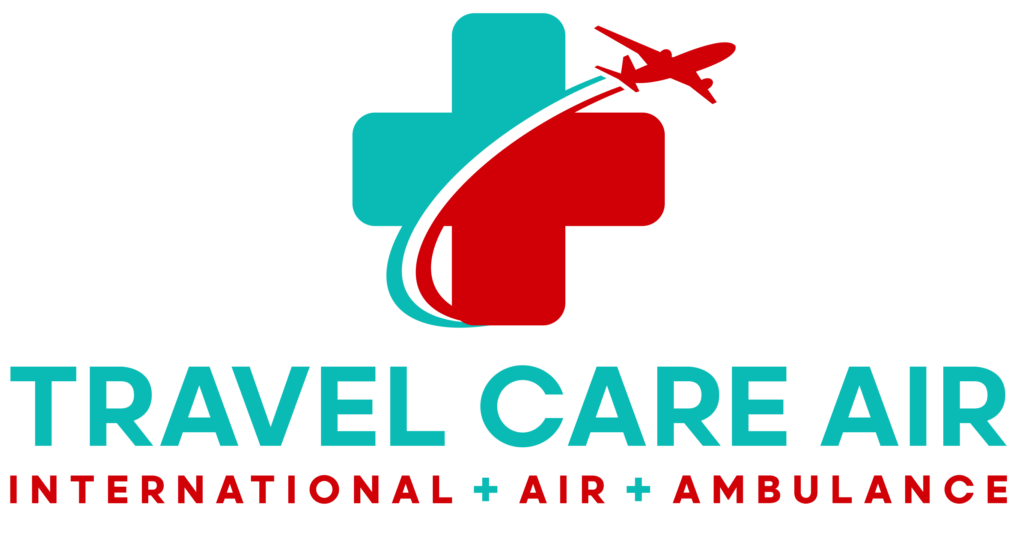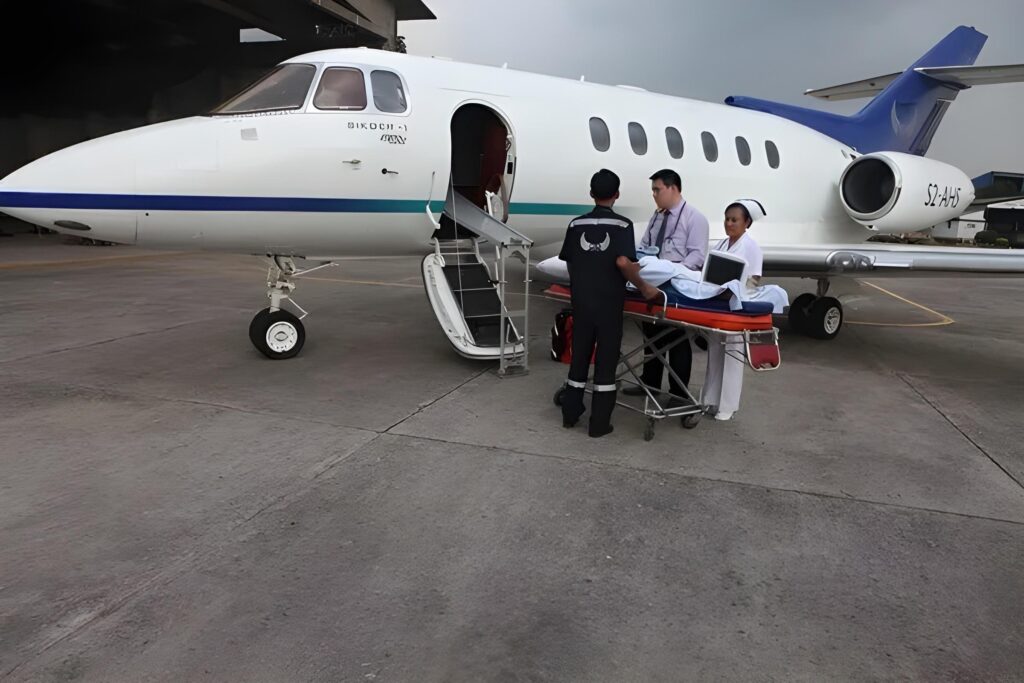Imagine that you or a loved one is on vacation, hiking, or driving through a remote area when a sudden medical emergency strikes out of nowhere. A local hospital isn’t properly equipped to handle the situation, and within minutes, a helicopter or jet is being prepared to transport you hundreds of miles to the nearest trauma center. At that moment, medical care is the only thing on your mind, but the bill that follows afterward can be staggering.
The cost of air transport often ranges from tens of thousands to well over $70,000, depending on distance you have to be flown and aircraft type that is used. For many families, that number comes as a complete shock, especially when they assume that health insurance for an air ambulance will automatically step in and take care of it. Unfortunately, that’s not always the case.
Policies can be complicated, and coverage can vary widely based on where you are, how the transport is classified, and whether the provider is in network. Understanding how insurance air ambulance benefits actually work before an emergency happens can help you avoid any devastating financial surprises.
Here’s what you’ll learn:
- What affects whether your health insurance for an air ambulance will pay for transport in an emergency.
- How to check your policy and find out exactly what is (and isn’t) covered.
- What to look for when choosing or updating your health plan to include air medical transport benefits.
- How travel insurance for air ambulance services can protect you when you’re away from home or overseas.
- What to do if your claim is denied and how to appeal or reduce out-of-pocket costs.
- The realistic cost expectations and steps you can take now to prepare before an emergency ever happens.
Why Air Ambulance Coverage Matters
When a serious emergency happens, mere minutes can mean the difference between life and death. In those moments, medical transport by air can help save a life by getting you or a loved one to the closest hospital that is properly equipped to provide critical care. But what often comes as a shock is the cost…air ambulance flights can range anywhere from $35,000 to $70,000 or even more, depending on the distance, the type of aircraft that is used, and level of medical support that is needed during the flight.
Many people believe that their regular health insurance automatically includes full coverage for air ambulance services, but that isn’t always the case. Policies often have strict limits or require that specific medical necessity criteria are met before their coverage applies. This is why families are sometimes left with unexpected bills that run into tens of thousands of dollars even after the insurance claim has been processed.
Asking the question does insurance cover air medical transport before an emergency happens can help you plan ahead and avoid those devastating surprises. By carefully going over your policy’s fine print, calling your insurance provider for extra clarification, and asking about pre-authorization rules, you can make sure that you know exactly what to expect. Preparing now means that if an emergency ever happens, you can focus on staying safe and getting the care that you need, instead of the financial stress that could follow.
How to Check If You’re Covered
Knowing whether or not your policy includes health insurance for an air ambulance can save you from some major financial stress later on. While many insurance plans include emergency transportation benefits, the details really do matter…especially when it comes to air ambulance services. The good news is that you can find out exactly what’s covered by your insurance by taking a few simple steps ahead of time.
Start by reviewing your Summary of Benefits and Coverage (SBC). This document outlines exactly what your plan pays for in an emergency. Look under sections labeled “Emergency Services,” “Ambulance Services,” or “Transportation.” Pay special attention to phrases like emergency transport, air evacuation, and medical repatriation. These are going to indicate whether air ambulance services might be included and under what circumstances.
Next, check for any exclusions. Some policies only cover ground ambulance transport or require that air services be deemed medically necessary. If you see unfamiliar language or unclear terms, highlight them for further clarification.
The next step is to call your insurance provider. Ask if they cover air ambulance transport and request written confirmation of the answer. Written proof is important in case a claim ever needs to be appealed.
When you talk to your insurer, mention specific terms like “air ambulance” and “medical flight.” This is going to help make sure that you’re discussing the right part of the policy. Confirm if there are any preferred or in-network providers for insurance air ambulance services, because using an out-of-network provider can lead to higher costs.
If you travel often or live in a rural area, ask about medical flight insurance coverage or other supplemental plans that specialize in emergency air transport. Taking these proactive steps can give you peace of mind, knowing that if a crisis ever comes up, you’ll know exactly where your coverage stands.
What to Look For in an Insurance Plan
Picking a policy that has good health insurance for an air ambulance requires looking beyond the basic emergency benefits and digging deep into all of the fine print. Start off with the plan types.
HMOs are usually more cost-efficient, but they can often require strict networks and prior authorization, which is an important factor when it comes to time-sensitive transports.
PPOs offer wider networks and are more forgiving out of network, which can matter when an air crew is dispatched from the nearest available base.
HDHPs paired with HSAs can work well if you travel often and want some savings set aside for large bills, but you should verify the air transport terms because high deductibles almost always still apply.
Before you enroll in any insurance plan, be sure to ask these important questions:
- Are air ambulance services treated as in network during emergencies, even if the provider is out of network?
- Is prior authorization required, and if so, how is that handled when minutes matter?
- Are there dollar caps per trip or per year on air services?
- Which medical criteria are used to determine if insurance covers air medical transport for my situation?
- Are ground-to-air transfers, ICU-level teams, and international repatriation included?
- How are balance-billing disputes handled if the air provider declines your plan’s rates?
Read through all of the exclusions closely. Some of the most common red flags include vague “ambulance” language that never specifically mentions aircraft, caps that are far below the typical air ambulance costs, and limitations that only allow medical transport by air between facilities within one specific network.
Look for explicit terms such as “air ambulance,” “air evacuation,” “medical repatriation,” and “nearest appropriate facility.” Confirm whether emergencies are paid at the highest benefit level regardless of network status and whether your plan has certain contracted air providers in your region.
Finally, get written confirmation from the insurer. That documentation, plus your plan’s Summary of Benefits and any medical policy bulletins, are what are going to help keep you protected when a real-world emergency requires fast, medically necessary air transport.
Understanding Medicare and Supplemental Options
For seniors and caregivers, understanding Medicare coverage for an air ambulance is an important part of making sure that you are properly prepared for any emergencies that may come your way. Medicare can help pay for air transport, but it has strict guidelines that determine when coverage applies.
Under Medicare Part B, air ambulance services are only covered when the patient’s condition is life-threatening and ground transportation would endanger their health or if it would take too long to reach the nearest medical facility that can provide the proper level of required care. The flight must also go to the closest appropriate hospital, not necessarily the one of your choice.
Even when air ambulance services are covered, Medicare generally only pays 80% of the approved amount after the yearly deductible, which leaves the patient responsible for the remaining 20%. This is where supplemental plans can really make a big difference. Medigap policies are specifically designed to fill these gaps by covering coinsurance, deductibles, or other out-of-pocket costs that are associated with emergency air transport.
If you have a Medicare Advantage Plan (Part C), the requirements may differ. Many Advantage Plans require preauthorization before transport can begin, even in urgent or life-threatening situations. It’s important to confirm how your specific plan handles air ambulance services and whether prior approval is needed.
By reviewing your benefits now and asking the right questions ahead of time, you can ensure that your health insurance for an air ambulance through Medicare or supplemental coverage provides all of the protection that you’ll need when time and care are of the highest priority.
Travel Insurance and International Coverage
If you travel often, live abroad part of the year, or enjoy taking cruises, understanding how travel insurance for air ambulance coverage works is one of the most important things you can do. Many people assume that their regular health insurance will protect them no matter where they are, but most U.S.-based policies provide limited or no coverage for medical transport outside of the country. That means if you become seriously ill or injured overseas, you could be responsible for the full cost of an air evacuation back to the United States, which can reach $50,000 to $200,000 depending on the distance and the location.
A good travel insurance plan should include medical evacuation and repatriation benefits. These are the parts of the policy that pay for transportation to the nearest hospital capable of providing adequate care, or, when necessary, to a hospital back home. When comparing plans, review both the coverage limits and the list of exclusions. Some policies only cover emergencies, while others limit coverage to certain regions or require pre-approval before arranging the flight.
For retirees that vacation abroad, long-term travelers, or frequent flyers, it’s definitely worth choosing a plan that clearly defines medical flight insurance coverage and includes a 24-hour assistance hotline that can help you coordinate transport. Also, check whether the policy works with your existing insurance air ambulance benefits at home to prevent overlapping or denied claims. Having reliable travel insurance ensures that no matter where you are, safe medical transport is always within reach in the event that an emergency strikes.
What to Do If Your Coverage Is Denied
If your claim for health insurance for an air ambulance is denied, it can feel really overwhelming, especially after an already stressful medical event. The good news is that a denial doesn’t always mean that the process is over. In many cases, you can appeal the decision and have it reviewed again, as long as you understand the steps to take and are able to gather up all of the right documentation.
Start by carefully reading the denial letter from your insurance company. It will explain why your claim was rejected, and you may see specific terms like “not medically necessary” or “alternative transport available.” These reasons are common and can often be challenged by providing additional evidence from your healthcare team.
When filing an appeal, it’s important that you include your doctor’s certification stating why air transport was essential in your situation, and why ground transportation would have put your health at risk. Attach any hospital transfer notes, travel logs, and all related invoices. It’s important that you submit these within the timeline that is listed in your insurer’s appeal policy.
If your appeal is denied again, don’t give up. You can request an external review by an independent reviewer or escalate your case to your state’s department of insurance for further investigation.
Be Prepared – Know Your Coverage Before You Fly
When an emergency happens, knowing your options for health insurance for an air ambulance can make all the difference. Taking time now to review your plan, confirm all of your coverage details, and ask questions about emergency transport can help you avoid any expensive surprises later on. Whether your coverage comes from a private insurer or Medicare coverage for an air ambulance, knowing the rules ahead of time is going to give you the ability to make confident, informed decisions when every second matters.
If you travel frequently or spend time abroad, having travel insurance for air ambulance services adds an extra layer of security. At Travel Care Air, our experienced team is here to help you understand your options, work with your insurance provider, and ensure that you or your loved one can get to the right facility safely and as quickly as possible.
Reach out today at 1-800-524-7633 or online to discuss coverage, plan ahead, and protect your peace of mind.
Frequently Asked Questions
Who pays for an air ambulance?
Payment depends entirely on your individual policy. If health insurance for an air ambulance is part of your coverage, your insurer may pay a portion (or even the full cost) of the flight. However, if the air provider is out of network, you could still face additional charges that are not covered by your plan. Always check your network status and request cost estimates in advance whenever possible.
What determines air ambulance costs?
Several factors influence the total bill, including flight distance, type of aircraft, number of medical staff onboard, and the equipment that is used during transport. Insurance air ambulance claims are also affected by where you were located at the time of the emergency and whether ground transport was a safe alternative.
How much does it cost to fly in an air ambulance?
Flights for medical transport by air usually range from $35,000 to $70,000. Costs can increase significantly for international flights, longer distances, or specialized medical teams that provide intensive care during travel.
Does travel insurance cover a medical flight?
Yes, some travel insurance for air ambulance plans include medical evacuation benefits. However, every policy is different, so it’s important to review your coverage details carefully. Check the limits, exclusions, and pre-authorization requirements for medical flight insurance coverage before you travel.
Will my insurance cover an air ambulance?
It depends on your provider and your policy’s emergency transport terms. Always verify whether your insurance covers air medical transport in your plan and ask your insurer to confirm that coverage in writing. Knowing your benefits ahead of time helps prevent unexpected expenses and ensures you get the care you need when every moment counts.


